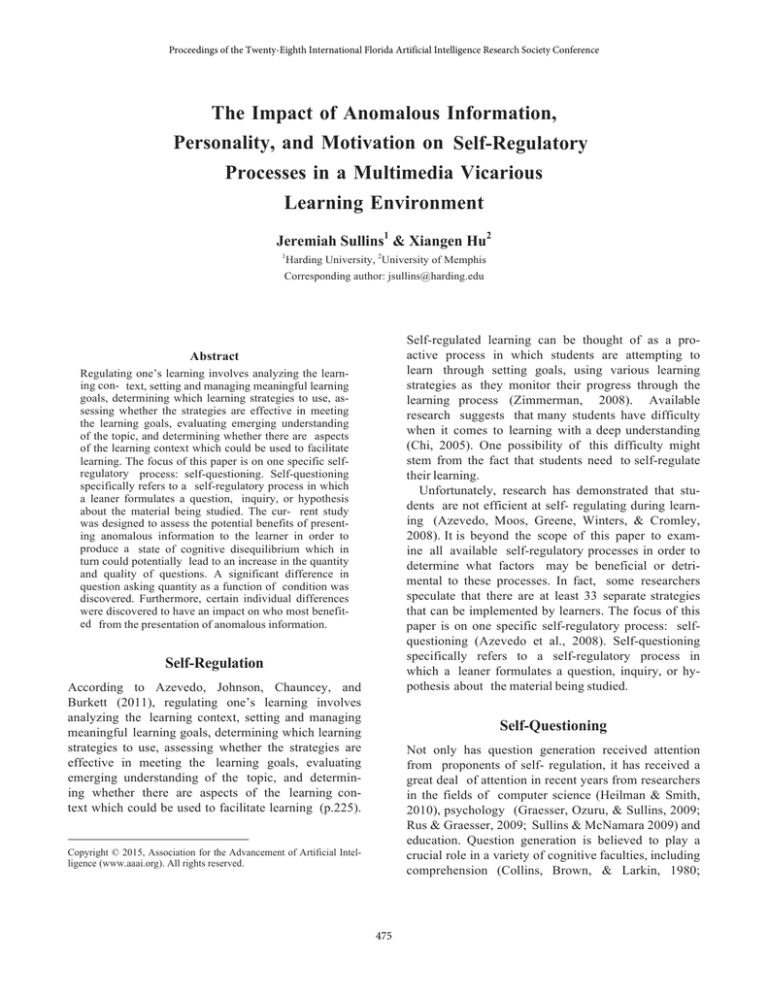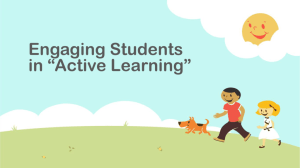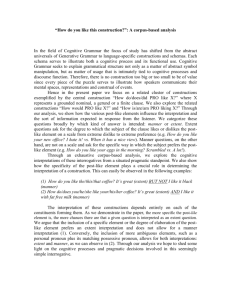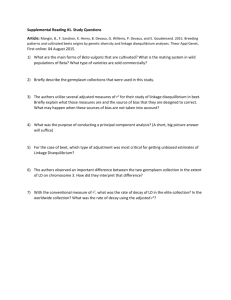The Impact of Anomalous Information, Personality, and Motivation on Self-Regulatory
advertisement

Proceedings of the Twenty-Eighth International Florida Artificial Intelligence Research Society Conference The Impact of Anomalous Information, Personality, and Motivation on Self-Regulatory Processes in a Multimedia Vicarious Learning Environment Jeremiah Sullins1 & Xiangen Hu2 1 Harding University, 2University of Memphis Corresponding author: jsullins@harding.edu Self-regulated learning can be thought of as a proactive process in which students are attempting to learn through setting goals, using various learning strategies as they monitor their progress through the learning process (Zimmerman, 2008). Available research suggests that many students have difficulty when it comes to learning with a deep understanding (Chi, 2005). One possibility of this difficulty might stem from the fact that students need to self-regulate their learning. Unfortunately, research has demonstrated that students are not efficient at self- regulating during learning (Azevedo, Moos, Greene, Winters, & Cromley, 2008). It is beyond the scope of this paper to examine all available self-regulatory processes in order to determine what factors may be beneficial or detrimental to these processes. In fact, some researchers speculate that there are at least 33 separate strategies that can be implemented by learners. The focus of this paper is on one specific self-regulatory process: selfquestioning (Azevedo et al., 2008). Self-questioning specifically refers to a self-regulatory process in which a leaner formulates a question, inquiry, or hypothesis about the material being studied. Abstract Regulating one’s learning involves analyzing the learning con- text, setting and managing meaningful learning goals, determining which learning strategies to use, assessing whether the strategies are effective in meeting the learning goals, evaluating emerging understanding of the topic, and determining whether there are aspects of the learning context which could be used to facilitate learning. The focus of this paper is on one specific selfregulatory process: self-questioning. Self-questioning specifically refers to a self-regulatory process in which a leaner formulates a question, inquiry, or hypothesis about the material being studied. The cur- rent study was designed to assess the potential benefits of presenting anomalous information to the learner in order to produce a state of cognitive disequilibrium which in turn could potentially lead to an increase in the quantity and quality of questions. A significant difference in question asking quantity as a function of condition was discovered. Furthermore, certain individual differences were discovered to have an impact on who most benefited from the presentation of anomalous information. Self-Regulation According to Azevedo, Johnson, Chauncey, and Burkett (2011), regulating one’s learning involves analyzing the learning context, setting and managing meaningful learning goals, determining which learning strategies to use, assessing whether the strategies are effective in meeting the learning goals, evaluating emerging understanding of the topic, and determining whether there are aspects of the learning context which could be used to facilitate learning (p.225). Self-Questioning Not only has question generation received attention from proponents of self- regulation, it has received a great deal of attention in recent years from researchers in the fields of computer science (Heilman & Smith, 2010), psychology (Graesser, Ozuru, & Sullins, 2009; Rus & Graesser, 2009; Sullins & McNamara 2009) and education. Question generation is believed to play a crucial role in a variety of cognitive faculties, including comprehension (Collins, Brown, & Larkin, 1980; Copyright © 2015, Association for the Advancement of Artificial Intelligence (www.aaai.org). All rights reserved. 475 pants were then randomly assigned to one of four different conditions. The multimedia-learning environment used in the current study was AutoTutor Lite. For the purpose of the current study, AutoTutor Lite was used as an information delivery system (See Figure 1). The four different conditions involving AutoTutor Lite were: 1) Pro War Unedited: participants listened to AutoTutor Lite deliver an opinionated article regarding why we should have started the Iraq war 2) Anti War Unedited: participants listened to AutoTutor Lite deliver an opinionated article regarding why we should not have started the Iraq war 3) Pro War Cognitive Disequilibrium: participants listened to AutoTutor Lite deliver the same opinionated article as in the Pro War Unedited condition, except in this condition, the article included erroneous information 4) Anti War Cognitive Disequilibrium: participants listened to AutoTutor Lite deliver the same opinionated article as in the Anti War Unedited condition, except in this condition, the article included erroneous information. Following the completion of the AutoTutor Lite intervention, participants completed the Motivated Strategies for Learning Questionnaire (Pintrich, Smith, Garcia, & McKeachie, 2001) along with the Big Five Personality Test. Participants were given as much time as needed to complete these tests. Graesser, Singer, & Trabasso, 1994) and reasoning (Graesser, Baggett, & Williams, 1996; Stern- berg, 1987). Asking good questions has been shown to lead to improved memory and comprehension of material in school children and adult populations (Rosenshine, Meister, & Chapman, 1996). Available research suggests that learning how to ask good questions should be taught at an early age but all ages benefit from question generation training (Wisher & Graesser, 2007). Sadly, consistent with the research coming out of self- regulation, it is well documented that the ideal scenario of a curious question asker does not match reality. Studentsare unspectacular at monitoring their own knowledge deficits and their question generation is both infrequent and unsophisticated (Dillon, 1988; Graesser & Person, 1994; Van der Meij, 1988). Graesser and Person (1994) reported that an individual student asks approximately one question in seven hours of class time (around one question per day). Most of these questions are not good questions, so the quality is also disappointing. Individual Differences and Question Asking One area of research that has not received a great amount of attention in the area of self-regulation is the influence of individual differences. There is ample evidence to suggest that individual differences do play a role in other areas of cognition such as the teaching of reading comprehension strategies (Briner, Kurby, McNamara, 2007; O’Reilly, Best, McNamara, 2004; Best, Rowe, Ozuru, & McNamara, 2005). However, to date few researchers have explored how individual differences may impact student question generation (e.g., Sullins & Graesser, 2014). Current Study The current study was designed to assess the potential benefits of presenting anomalous information to the learner in order to produce a state of cognitive disequilibrium which in turn could potentially lead to an increase in the quantity and quality of questions. Figure 1. Example screenshot of AutoTutor Lite Results A significant difference in question asking quantity as a function of condition was discovered, F (3,69) = 4.63, p = .005, η2 = .168. Upon further exploration, it was revealed that participants in the Pro War Cognitive Disequilibrium condition (M = 2.12, SD = 1.89) asked significantly more questions than the participants in the Anti War Cognitive Disequilibrium condition (M = .55, SD = .78) and the Anti War condition (M = .77, SD = Procedure After completing the informed consent, the participants completed a demographics questionnaire. Following the demographics questionnaire, participants completed the Gates MacGinitie Reading Comprehension test. Partici- 476 4.68), compared to participants in the Anti War Cognitive Disequilibrium condition (M = 4.18), Pro War condition (M = 4.32), and Anti War condition (M= 3.64). Test anxiety, according to the MSLQ manual, refers in part with preoccupation and concern regarding task performance. It could be that the participants in the Pro War Cognitive Disequilibrium condition were more concerned with their task performance and therefore asked more questions to ensure they would perform well. Another potential explanation for unexpected results could be a result of the reading comprehension as measured by the Gates MacGinitie reading comprehension test. Participants in the Pro War Cognitive Disequilibrium condition scored on average one percentage point lower than the participants in the Anti War Cognitive Disequilibrium condition, five percentage points lower than participants in the Anti War condition, and eight percentage points lower than the participants in the Pro War condition. As can been seen in the screenshot of AutoTutor Lite in Figure 1, AutoTutor Lite not only utilizes a text to speech engine but also has text bubbles present on the screen. It is possible that due to the difficulties in understanding, some learners relied heavily on the speech bubbles provided by AutoTutor Lite. If participants in the Pro War Cognitive Disequilibrium condition attempted to rely on the speech bubbles, due to lower reading comprehension scores, they may have not fully understood the material being covered and therefore asked a significantly higher proportion of questions during the learning session. It also warrants mentioning that although the rate of question asking across all four conditions might look relatively low, this is actually a vast improvement from the previous findings. More specifically, as previously mentioned, Graesser and Person (1994) found that an average student in a typical classroom setting will only ask 1 question for every 7 hours in the classroom. However, in our Pro War Cognitive would result in approximately 148 questions every 7 hours! 1.09). Furthermore, a marginally significant difference was discovered between the participants in the Pro War Cognitive Disequilibrium condition (M = 2.12) and the participants in the Pro War condition (M = 1.31, SD = 1.97). Following the analysis exploring the differences in question asking among conditions, the participants were split into two different categories in order to determine if there were any differences in pro versus anti war. More specifically, participants were either in the Pro War conditions (both cognitive disequilibrium and unedited) or Anti War conditions (both cognitive disequilibrium and unedited). Results revealed a significant difference between the two groups, F (1,71) = 10.41, p = .002. Participants that were in the Pro War conditions (M = 1.69, SD = 1.72) asked significantly more questions during their learning session than the participants in the Anti War conditions (M= .65, SD = .94). Furthermore correlational analyses were conducted in order to determine if there were any relationships that existed between learners’ individual differences and the number of questions that were generated. A significant correlation was discovered between the MSLQ variable test anxiety and the number of questions asked during the learning session (r = .248, p = .035). Additionally, a marginal significant correlation was revealed between the number of questions that the participants asked during their learning session and their viewpoint on the most recent Iraq war (assessed in the demographics questionnaire) (r = .195, p = .09). Discussion It was predicted that learners who were placed in a state of cognitive disequilibrium (based on the presentation of erroneous information) would produce a significantly higher amount of raw questions than the learners in the non- cognitive disequilibrium conditions. However, our results were not in the predicted direction. One potential explanation for these findings could be due in some degree to individual differences among participants. For example, as mentioned in the results, there was a significant correlation between the MSLQ variable test anxiety and the number of questions asked during the learning session. Analysis revealed that although there was not a significant difference among conditions regarding test anxiety, F (3,69) = 1.58, p =.203, there were some interesting trends that were revealed during the analysis. Results showed that participants in the Pro War Cognitive Disequilibrium condition on average had the highest test anxiety score (M = References Collins, A., Brown, J. S., & Larkin, K. M. (1980). Inference in text understanding. In R.J. Spiro, B. C. Bruce, & W. F. Brewer (Eds.) Theoretical issues in reading comprehension (pp. 385-407). Hillsdale, NJ: Erlbaum. Dillon, J. T. (1988). Questioning and teaching: A manual of practice. New York: Teachers College Press. Graesser, A. C., Baggett, W., & Williams, K. (1996). Question-driven explanatory reasoning. Applied Cognitive Psychology, 10, 17-32. Graesser, A. C., Ozuru, Y., & Sullins, J. (2009). What is a good question? In M. G. McKeown & L. Kucan (Eds.), 477 Threads of coherence in research on the development of reading ability (pp. 112-141). NY: Guilford. Graesser, A. C, & Person, N. (1994). Question asking during tutoring. American Educational Research Journal, 31, 104-137. Graesser, A. C., Singer, M., & Trabasso, T. (1994). Constructing inferences during narrative text comprehension. Psychological Review, 3, 371-395. Heilman, M., & Smith, N. A. (2010). Extracting Simplified Statements for Factual Question Generation. In K. E. Boyer & P. Piwek (Eds.), QG2010: The Third Workshop on Question Generation (11-20). Springer:Berlin / Heidelberg. Pintrich, P. R., Smith, D., Garcia, T., and McKeachie, W. (1991). A Manual for the Use of the Motivated Strategies for Learning Questionnaire (MSLQ), The University of Michigan, Ann Arbor, MI. Rosenshine, B., Meister, C., & Chapman, S. (1996). Teaching students to generate questions: A review of the intervention studies. Review of Educational Research, 66, 181-221. Sternberg, R. J. (1987). Questioning and intelligence. Question Exchange, 1, 11-13. Sullins, J., & Graesser, A. C. (2014). The relationship between cognitive disequilibrium, emotions, and individual differences on student question generation. International Journal of Learning Technology, 9(3), 221-247. Sullins, J., & McNamara, D.S. (2009). iSTART question training module: Training students efficient questioning skills. Presented at the 2nd workshop on Question Generation, Brighton, United Kingdom. Van der Meij, H. (1988). Constraints on question asking in class- rooms. Journal of Educational Psychology, 80, 401-405. Wisher, R. A., & Graesser, A. C. (2007). Question asking in advanced distributed learning environments. In S. M. Fiore & E. Salas (Eds.), Toward a science of distributed learning and training (pp. 209–234). Washington, DC: American Psychological Association. 478





